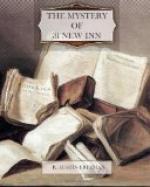“A more important inference is to be drawn from the collected signatures. I have remarked that the change in the signature occurred abruptly, with one or two alterations of manner, last September, and that there are two distinct forms with no intermediate varieties. This is, in itself, remarkable and suspicious. But a remark made by Mr. Britton furnishes a really valuable piece of evidence on the point we are now considering. He admitted that the character of the signature had undergone a change, but observed that the change did not affect the individual or personal character of the writing. This is very important; for handwriting is, as it were, an extension of the personality of the writer. And just as a man to some extent snares his personality with his near blood-relations in the form of family resemblances, so his handwriting often shows a subtle likeness to that of his near relatives. You must have noticed, as I have, how commonly the handwriting of one brother resembles that of another, and in just this peculiar and subtle way. The inference, then, from Mr. Britton’s statement is, that if the signature of the will was forged, it was probably forged by a relative of the deceased. But the only relative in question is his brother John.
“All the facts, therefore, pointed to John Blackmore as the person who occupied these chambers, and I accordingly adopted that view as a working hypothesis.”
“But this was all pure speculation,” objected Mr. Winwood.
“Not speculation,” said Thorndyke. “Hypothesis. It was ordinary inductive reasoning such as we employ in scientific research. I started with the purely tentative hypothesis that the person who signed the will was not Jeffrey Blackmore. I assumed this; and I may say that I did not believe it at the time, but merely adopted it as a proposition that was worth testing. I accordingly tested it, ‘Yes?’ or ‘No?’ with each new fact; but as each new fact said ‘Yes,’ and no fact said definitely ‘No,’ its probability increased rapidly by a sort of geometrical progression. The probabilities multiplied into one another. It is a perfectly sound method, for one knows that if a hypothesis be true, it will lead one, sooner or later, to a crucial fact by which its truth can be demonstrated.
“To resume our argument. We have now set up the proposition that John Blackmore was the tenant of New Inn and that he was personating Jeffrey. Let us reason from this and see what it leads to.
“If the tenant of New Inn was John, then Jeffrey must be elsewhere, since his concealment at the inn was clearly impossible. But he could not have been far away, for he had to be producible at short notice whenever the death of Mrs. Wilson should make the production of his body necessary. But if he was producible, his person must have been in the possession or control of John. He could not have been at large, for that would have involved the danger of his being seen and recognized. He could not have been in any institution or place where he would be in contact with strangers. Then he must be in some sort of confinement. But it is difficult to keep an adult in confinement in an ordinary house. Such a proceeding would involve great risk of discovery and the use of violence which would leave traces on the body, to be observed and commented on at the inquest. What alternative method could be suggested?




